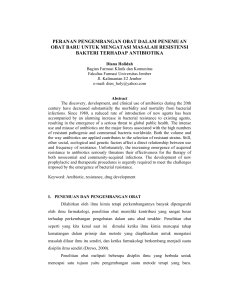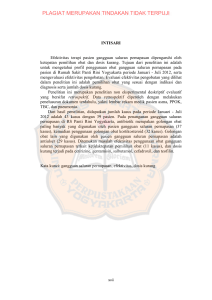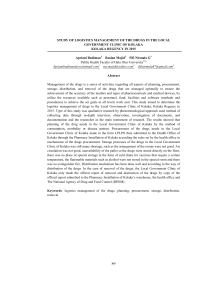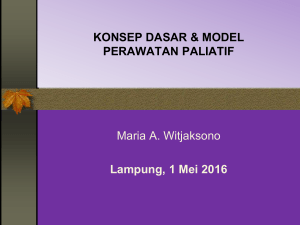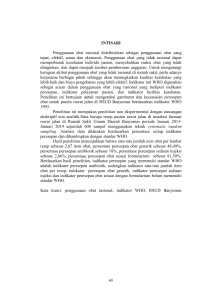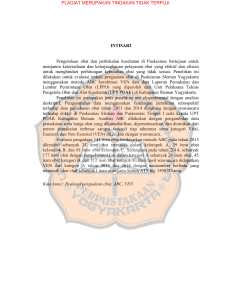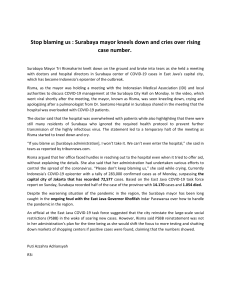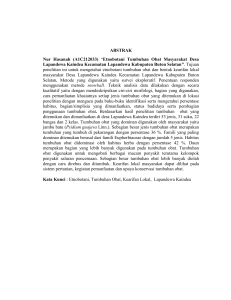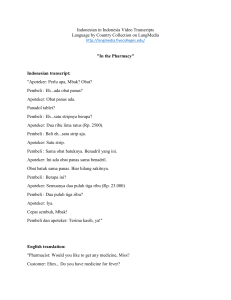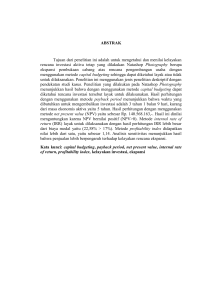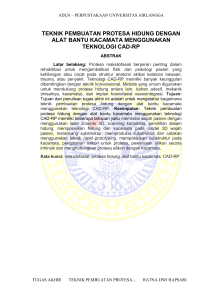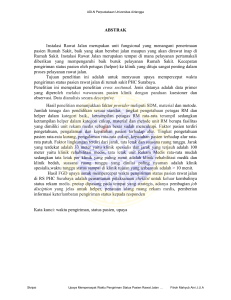Profil Kompatibilitas Sediaan Obat Intravena dengan Pelarut pada
advertisement
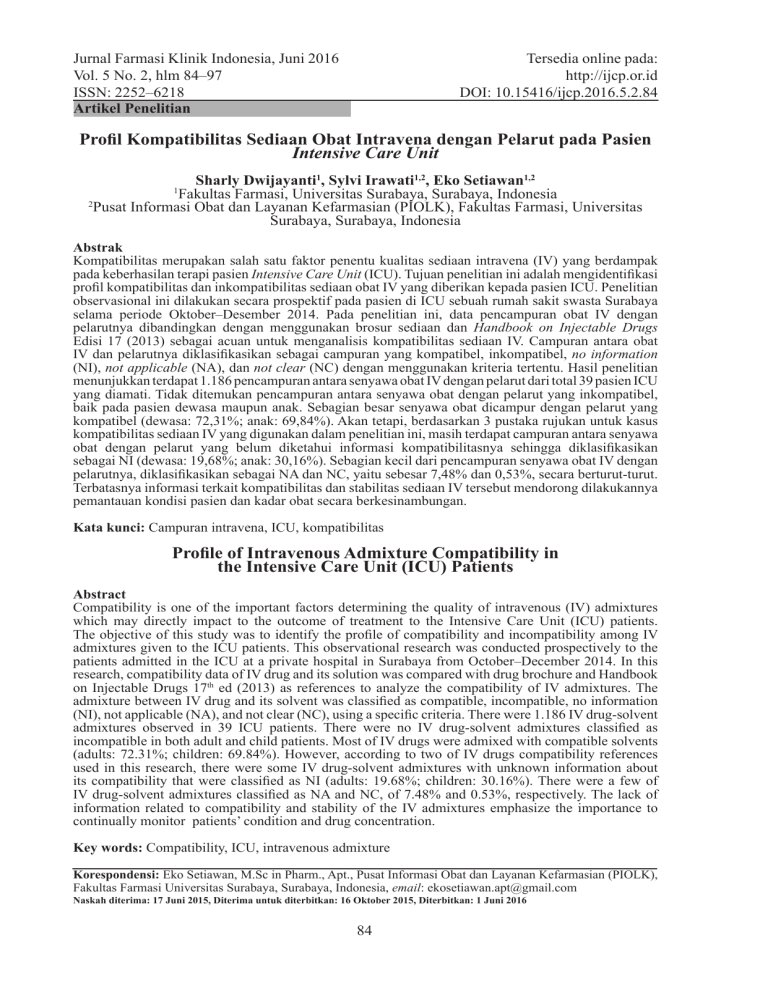
Jurnal Farmasi Klinik Indonesia, Juni 2016 Vol. 5 No. 2, hlm 84–97 ISSN: 2252–6218 Artikel Penelitian Tersedia online pada: http://ijcp.or.id DOI: 10.15416/ijcp.2016.5.2.84 Profil Kompatibilitas Sediaan Obat Intravena dengan Pelarut pada Pasien Intensive Care Unit Sharly Dwijayanti1, Sylvi Irawati1,2, Eko Setiawan1,2 Fakultas Farmasi, Universitas Surabaya, Surabaya, Indonesia 2 Pusat Informasi Obat dan Layanan Kefarmasian (PIOLK), Fakultas Farmasi, Universitas Surabaya, Surabaya, Indonesia 1 Abstrak Kompatibilitas merupakan salah satu faktor penentu kualitas sediaan intravena (IV) yang berdampak pada keberhasilan terapi pasien Intensive Care Unit (ICU). Tujuan penelitian ini adalah mengidentifikasi profil kompatibilitas dan inkompatibilitas sediaan obat IV yang diberikan kepada pasien ICU. Penelitian observasional ini dilakukan secara prospektif pada pasien di ICU sebuah rumah sakit swasta Surabaya selama periode Oktober–Desember 2014. Pada penelitian ini, data pencampuran obat IV dengan pelarutnya dibandingkan dengan menggunakan brosur sediaan dan Handbook on Injectable Drugs Edisi 17 (2013) sebagai acuan untuk menganalisis kompatibilitas sediaan IV. Campuran antara obat IV dan pelarutnya diklasifikasikan sebagai campuran yang kompatibel, inkompatibel, no information (NI), not applicable (NA), dan not clear (NC) dengan menggunakan kriteria tertentu. Hasil penelitian menunjukkan terdapat 1.186 pencampuran antara senyawa obat IV dengan pelarut dari total 39 pasien ICU yang diamati. Tidak ditemukan pencampuran antara senyawa obat dengan pelarut yang inkompatibel, baik pada pasien dewasa maupun anak. Sebagian besar senyawa obat dicampur dengan pelarut yang kompatibel (dewasa: 72,31%; anak: 69,84%). Akan tetapi, berdasarkan 3 pustaka rujukan untuk kasus kompatibilitas sediaan IV yang digunakan dalam penelitian ini, masih terdapat campuran antara senyawa obat dengan pelarut yang belum diketahui informasi kompatibilitasnya sehingga diklasifikasikan sebagai NI (dewasa: 19,68%; anak: 30,16%). Sebagian kecil dari pencampuran senyawa obat IV dengan pelarutnya, diklasifikasikan sebagai NA dan NC, yaitu sebesar 7,48% dan 0,53%, secara berturut-turut. Terbatasnya informasi terkait kompatibilitas dan stabilitas sediaan IV tersebut mendorong dilakukannya pemantauan kondisi pasien dan kadar obat secara berkesinambungan. Kata kunci: Campuran intravena, ICU, kompatibilitas Profile of Intravenous Admixture Compatibility in the Intensive Care Unit (ICU) Patients Abstract Compatibility is one of the important factors determining the quality of intravenous (IV) admixtures which may directly impact to the outcome of treatment to the Intensive Care Unit (ICU) patients. The objective of this study was to identify the profile of compatibility and incompatibility among IV admixtures given to the ICU patients. This observational research was conducted prospectively to the patients admitted in the ICU at a private hospital in Surabaya from October–December 2014. In this research, compatibility data of IV drug and its solution was compared with drug brochure and Handbook on Injectable Drugs 17th ed (2013) as references to analyze the compatibility of IV admixtures. The admixture between IV drug and its solvent was classified as compatible, incompatible, no information (NI), not applicable (NA), and not clear (NC), using a specific criteria. There were 1.186 IV drug‑solvent admixtures observed in 39 ICU patients. There were no IV drug-solvent admixtures classified as incompatible in both adult and child patients. Most of IV drugs were admixed with compatible solvents (adults: 72.31%; children: 69.84%). However, according to two of IV drugs compatibility references used in this research, there were some IV drug-solvent admixtures with unknown information about its compatibility that were classified as NI (adults: 19.68%; children: 30.16%). There were a few of IV drug-solvent admixtures classified as NA and NC, of 7.48% and 0.53%, respectively. The lack of information related to compatibility and stability of the IV admixtures emphasize the importance to continually monitor patients’ condition and drug concentration. Key words: Compatibility, ICU, intravenous admixture Korespondensi: Eko Setiawan, M.Sc in Pharm., Apt., Pusat Informasi Obat dan Layanan Kefarmasian (PIOLK), Fakultas Farmasi Universitas Surabaya, Surabaya, Indonesia, email: [email protected] Naskah diterima: 17 Juni 2015, Diterima untuk diterbitkan: 16 Oktober 2015, Diterbitkan: 1 Juni 2016 84
